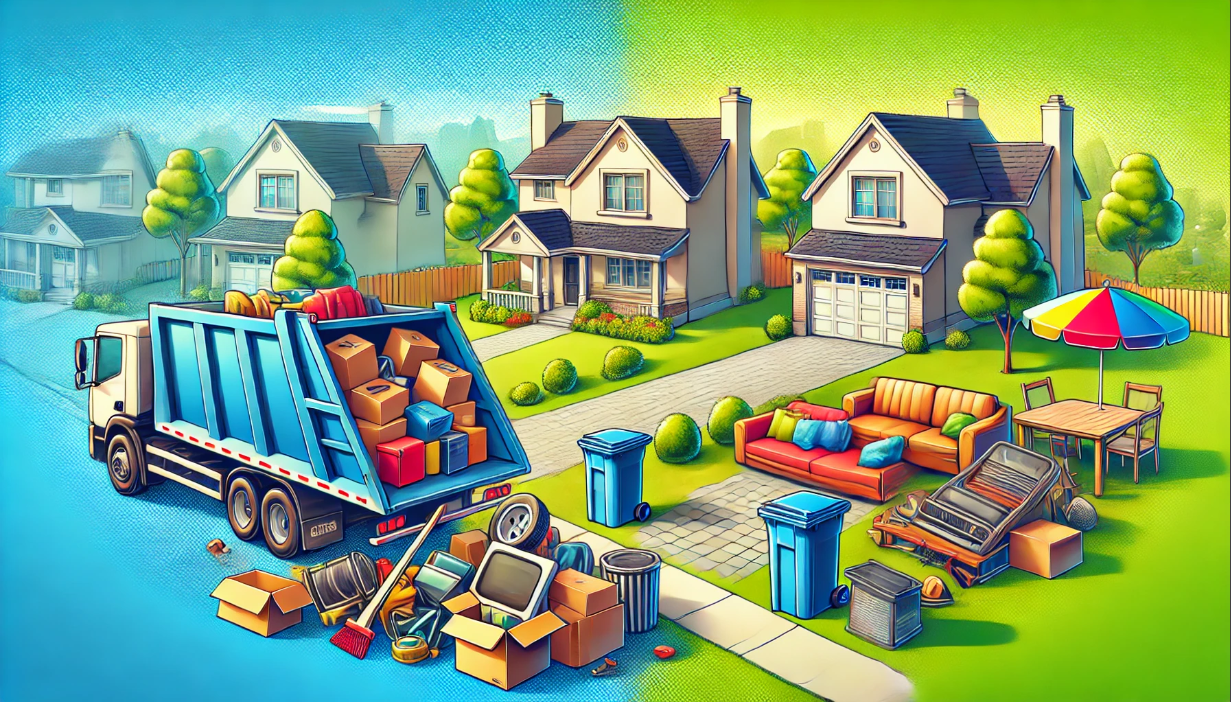
How to Organize Residential Junk Removal: A Step-by-Step Guide
When your home becomes cluttered with unwanted items, old furniture, and unused appliances, it’s time to consider residential junk removal. Removing junk not only creates more space but also improves your quality of life. This guide will walk you through the steps to make the junk removal process easy and efficient.
What is Residential Junk Removal?
Residential junk removal involves clearing unwanted or unused items from your home. These can include old furniture, appliances, yard waste, and other household debris. Proper junk removal ensures that items are either recycled, donated, or disposed of in a responsible manner.
Why is Junk Removal Important?
Removing clutter not only creates a cleaner, more organized home but also:
- Improves mental health: Living in a clutter-free environment reduces stress and improves focus.
- Increases living space: Junk removal frees up space that can be used for storage or other purposes.
- Promotes safety: Eliminating unused items reduces the risk of accidents in your home.
- Supports environmental sustainability: Proper junk disposal methods ensure that recyclable materials don’t end up in landfills.
How to Prepare for Junk Removal
Before jumping into the junk removal process, some planning is essential. Here’s how to get started:
1. Assess Your Junk
The first step is determining what items need to be removed. Walk through your home and make a list of everything you no longer need. Items may include:
- Old furniture
- Broken electronics
- Appliances that no longer work
- Outgrown or damaged clothing
- Yard debris or construction materials
Make sure to separate hazardous materials like batteries or chemicals, as these require special disposal methods.
2. Organize by Category
Once you’ve assessed your junk, organize it into categories. This will make the process smoother:
- Donate: Items that are in good condition, such as furniture or clothing.
- Recycle: Electronics, metals, and plastics.
- Trash: Items that are damaged or no longer useful.
DIY Junk Removal vs. Hiring Professionals
Deciding whether to tackle junk removal on your own or hire a professional service depends on a few factors. Here's a breakdown of both options.
DIY Junk Removal
- Pros:
- Cost-effective: You’ll save money by not paying for professional services.
- Flexible: You can do it on your own schedule.
- Cons:
- Time-consuming: Sorting, transporting, and disposing of items can take days or weeks.
- Limited resources: You may need to rent a truck or tools for heavy lifting.
- Disposal issues: Not all local waste facilities accept certain types of junk.
Hiring Professional Junk Removal Services
- Pros:
- Efficient: Professionals handle everything from loading to disposal.
- Convenient: You won’t need to lift heavy items or worry about transport.
- Eco-friendly: Many services recycle or donate usable items, reducing waste.
- Cons:
- Cost: Professional services charge based on the amount of junk or the time required for removal.
- Scheduling: You’ll need to book an appointment, which might not always fit your timeline.
Steps for DIY Junk Removal
If you’ve decided to handle junk removal on your own, follow these steps to ensure a smooth process:
1. Rent a Dumpster or Truck
Depending on how much junk you’re dealing with, renting a dumpster or truck might be necessary. Make sure to choose the right size for your project. You can rent dumpsters for several days, giving you flexibility to work at your own pace.
2. Start with the Big Items
Begin by removing the largest items like furniture and appliances. Breaking these down into smaller pieces will make them easier to transport.
3. Sort Recyclables and Donations
Set aside items that can be donated or recycled. Many charities accept furniture, clothing, and electronics that are still in good condition. Check with local recycling centers for materials such as metals, plastics, and electronics.
4. Dispose of Hazardous Materials Safely
Chemicals, batteries, and paints must be disposed of at designated hazardous waste facilities. Check with your local government for drop-off locations and guidelines.
Benefits of Hiring Professional Junk Removal
Professional junk removal services can offer peace of mind and convenience. Here are the key benefits:
- Quick Turnaround: Professionals can often complete the removal process in a few hours.
- Eco-Conscious Disposal: Many companies ensure proper recycling and donation of items.
- Stress-Free: No need to lift heavy objects or deal with transporting junk to disposal sites.
Junk Removal Options at a Glance
| Option | Benefits | Drawbacks |
|---|---|---|
| DIY Junk Removal | Cost-effective, flexible schedule | Time-consuming, physically demanding |
| Hiring Professionals | Fast, convenient, eco-friendly disposal | More expensive, requires scheduling in advance |
| Dumpster Rental | Can work at your own pace, suitable for larger projects | Requires heavy lifting, may need permits |
| Curbside Pickup Services | Convenient, usually affordable | Limited to certain types of junk, specific pickup dates |
Common Questions About Residential Junk Removal
Q: What items can be recycled during junk removal?
A: Items such as electronics, metals, plastics, glass, and certain types of furniture can often be recycled. Always check with your local recycling center for a complete list of acceptable materials.
Q: How do I dispose of hazardous materials?
A: Hazardous materials, such as paint, batteries, and cleaning chemicals, need to be taken to a specialized waste disposal facility. Local governments typically provide drop-off locations for these items.
Q:Can I donate items instead of throwing them away?
A: Yes! Many items, including furniture, clothing, and electronics, can be donated to local charities or organizations. Check with donation centers in your area to find out what they accept.
Residential junk removal doesn’t have to be overwhelming. By following the steps outlined in this guide, you can tackle clutter efficiently, whether you choose to do it yourself or hire professionals. Remember, the key is proper planning, organizing your junk, and choosing the best disposal methods. By donating and recycling where possible, you’ll not only create more space in your home but also contribute to a cleaner environment.

